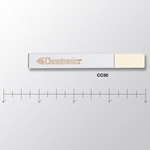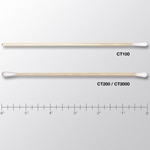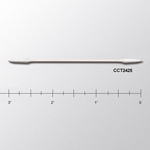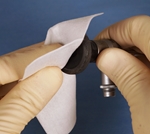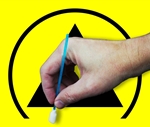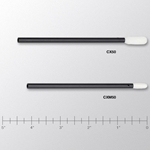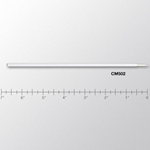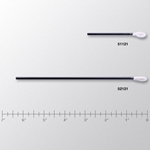How to Choose The Right Swab for Medical Device Assembly, Electronics & More
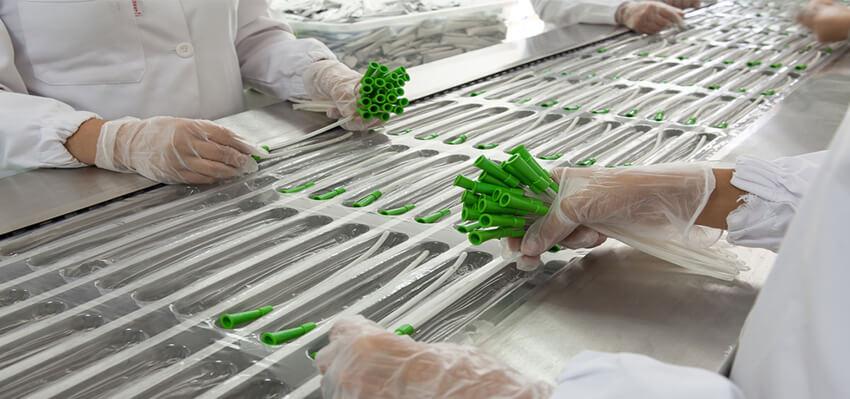
Swabs are often thought of as just tufts of cotton fiber wrapped around a stick. And while cotton swabs have their uses, more complex solutions are needed for critical industries like medical device assembly, cleanroom, electronic manufacturing, and PCB assembly.
Swabs are useful precision tools for technicians and operators to perform delicate and meticulous tasks like precision cleaning, repair, and assembly. In this post, we'll cover the swab selection process of four common critical swab applications and their properties:
- Precision cleaning and contamination removal
- Application of critical fluids e.g. lubricants, adhesives, coatings, dopants, treatments
- Cleaning validation and surface sampling
- Static sensitive applications
Types of Swabs
First, let's review the common swabs that are used in critical applications. Keep in mind that some swabs may be a cross between one or more swabs. For example, there are foam swabs with cotton interiors and also wrapped polyester swabs.
Cotton Swabs

Traditional cotton bud swabs are best suited for non-critical applications because of linting
- Most common swab
- Moderate absorbency, soft, low cost
- Used in many areas such as personal hygiene, DNA testing, cell collection, medical field to law enforcement
- Ideal for one-time use
- Leaves behind fibers
- Not as strong or durable as other swabs
Pointed wrapped foam swab
- Super absorbent
- An upgrade from cotton due to cleanliness and toughness
- Economical and ideal when used with alcohol
- Doesn't leave behind fibers
- Not ideal for scrubbing with harsh solvents like toluene and ketones
- Can tolerate harsh solvents only for short time period
Closed Cell Polyurethane Swabs
- Not as absorbent as open cell polyurethane swabs
- Stronger than Open Cell Polyurethane Swabs
- Resistant to tearing and abrasion
- Doesn’t leave behind fibers
Knitted (woven) Polyester Swabs
Pointed polyester swab for high precision applications
- Resistant to many solvent chemicals
- Superior scrubbing ability
- Best for sampling due to great absorption and release ability
- Naturally lowest in NVR (non-volatile residue)
Electro-Static Dissipative Swabs

Swab with dissipative handle
- Can be made out of foam or cotton
- Protects delicate microcircuits from static discharge damage which can destroy or weaken sensitive microcircuits
- Dissipates existing static and prevents static build-up in use
- Usually more expensive than non-ESD swabs
- Only blue are completely chemically resistant
Wrapped fabric “pillow” shaped swab
- Can be made of cotton, foam, or polyester
- Has no sealed edges, so no risk of scratching delicate substrates
- No sealed edges also
means that it generates fewer particles since most particles come from cut edges - Has high and low areas, the high spots wipe the surface like a squeegee and the low spots collect the soils
- High capacity relative to a fine point for applying lubricant etc., liquid wicks to the tip
- Hand-made so they are usually more expensive than machine-made swabs
Selecting a Swab for Effective Precision Cleaning and Contamination Removal
When choosing a swab for precision cleaning, the substrate and soil must first be considered because those conditions dictate if a cleaning solution is required and what kind is needed.
Smooth surfaces can be used with any swab along with a gentle solvent like IPA alcohol. Rough, abrasive, or 'snag-prone' surfaces require a stronger material than cotton. Chemically sensitive substrates such as rubber, silicones, and acrylics also need light solvents such as IPA, light naphtha, heptane, or isohexanes.
For light soils, all swab types are appropriate for use, including polyurethane foam, polyester fiber, and cotton swabs. Open-cell, polyurethane foam swabs are common for cleaning because the reticulated structure captures and holds the particles and liquids within the foam. Unlike cotton swabs, polyurethane foam swabs have no fibers that can be released and left behind. Common mild solvents like isopropyl alcohol and light hydrocarbons will work well with all of the aforementioned swabs.
Difficult to remove soils like greases, waxes, fluxes, excess adhesives, and coatings require stronger materials and may require using strong solvents and scrubbing. Cotton swabs and foam swabs will fray or tear with aggressive scrubbing, and
Knitted polyester swabs are very robust and unaffected by any solvent or solution that would be used for precision hand cleaning. Such solvents include ketones (acetone and MEK), aromatics (toluene and xylene), esters (n-butyl acetate), halogenated solvents and commercial formulations. They offer superior scrubbing ability to remove baked-on and burned-on greases, partially cured adhesives and coatings and dried on flux residues. Knitted polyester abrasion resistance makes it the best choice for scrubbing on rough surfaces, crusty contaminants, and around PCB components and leads which would shred softer materials such a foam.
Precision Cleaning Selection Review
- Identify the substrate. Determining the substrate will narrow down the type of swab that you need. Plus, it helps limit the type of solvents that are available to your application.
- Identify the soil that you are cleaning. Whether it's easy to remove dust, particulates, and light oils, or difficult to remove soils such as greases, fluxes, adhesives, waxes, and coatings.
- Decide if a cleaning solvent is necessary. By now you will have enough information to know if and what kind of solvent is needed.
- Select swab. For gentle cleaning with nothing or a mild solvent, use any swab. Foam for low cost, quick single use, softness, and conformity to a surface. Polyester for highest cleanliness and highest strength. For aggressive cleaning with a solvent, consider a chemically tolerant swab like polyester. If cleaning an abrasive surface, consider a stronger swab like polyester. If you are working on sensitive electronics, see details on static dissipative swab handles below.
- Match swab size and shape to the area, recess, or crevice being cleaned.
Selecting a Swab for Applying Fluids (Adhesives, Coatings, and Lubricants)
Material compatibility is the most important property to consider when selecting a swab for application purposes. Both the swab head and the handle must tolerate the material being applied.
Adhesives, coatings, and lubricants are often applied with a carrier solvent which can degrade the swab. Therefore, parts of the swab may be applied along with the adhesive or coating degrading both the performance and appearance. In this scenario, polyester swab heads, which are the most chemically resistant, are the best choice.
Swab size, shape, and geometry are the other critical properties. Small pointed swabs are good for applying small precise drops of fluid to specific spots. However, if the task is applying fluid over a larger area, larger swabs with high fluid capacity are a better choice - matching the size and shape of the area.

Constantly rewetting a low capacity swab can be time-consuming and tedious. And depending on how the swab is used, frequent re-wetting with the fluid being applied increases the likelihood of cross-contamination and transferring contamination to the fluid reservoir.
Such cross-contamination concerns also encourage one and
- Identify the chemical fluid being applied and how it will affect the swab head and handle.
- Select a swab material that is chemically compatible with the fluid. Does the fluid contain an aggressive solvent carrier? If so, polyester swab heads are typically the most chemically resistant. However impervious materials like PVDF (polyvinylidene fluoride) are also available. Such swabs can be used once or continuously depending on the users’ tolerance for possible cross-contamination.
- Select swab with proper shape and capacity that matches the task at hand
- Identify the static sensitivity of the substrate. If you are working on sensitive electronics, see details on static dissipative swab handles below.
Selecting a Swab for Surface Sampling and Cleaning Validation
Cleaning validation is a process where a swab (usually with a collection solvent, solution, or pure water) is rubbed on a surface to collect possible contaminants. The contamination is then extracted from the swab and analyzed. Complete cleaning and rinsing away of all residue is usually validated by Total Organic Carbon (TOC) testing. The analysis can also be FTIR, NMR or another spectrographic or chromatographic technique when looking for a specific chemical
This procedure is used most frequently in the pharmaceutical industry to ensure that no cross-contamination occurs between drug production batches or that a batch of drugs is not contaminated with cleaning chemicals.
Select a highly cleaned swab head material compatible with the collection fluid and low in background contamination. Polyester knit is ideal for this purpose because of its unique competency at absorbing contamination from the surface then releasing the contamination back into an extraction solution for analysis. In addition, the cleanliness of synthetic polyester is consistent, controlled, and engineered through the entire process from polyester polymer formulation through swab packaging.
Polyester is also one of the most cleanable cleanroom materials, which means that it can be produced and thoroughly cleaned to produce swabs with extremely low
It’s important to have little or no background contamination from the swab so the reading is highly accurate. High background contamination masks collected contamination and reduce precision and accuracy. The swabs should be made without adhesives or glue which are often a source for extractable contaminants.
- Identify the collection solution
- Select the swab head material: For highly sensitive tests, choose polyester knit with extra post production cleaning that is thermally bonded to the handle. This minimizes the potential for background contamination from the swab.
- Select a swab handle that is appropriate to the application. Stiff handles that cut or break cleanly, and can be notched for a clean break. Chemically inert handles are important to avoid contributing to background contamination.
- Avoid buying in large pack sizes. Smaller pack sizes so fewer swabs are susceptible to contamination when the package is opened.
Selecting a Swab for Static Control
Many electronic devices and printed circuit boards (PCBs) have circuits that can be damaged by rapid high voltage electrostatic discharge (ESD). Devices can be rendered inoperable immediately or have their in-service life shortened. A source of the static field can be the technician performing service work, generated by the material of the swab rubbing against the surface and
The risk of ESD damage can be reduced by using a swab with a static dissipative (or ESD-safe) handle. Static dissipative swabs can drain the static charge field slowly so the damage is eliminated when working on sensitive electronics.

A completed path from the swab to the ground is required, usually through the operator's hands (or ESD-safe gloves) and then a wrist grounding strap. In addition, the swab head needs to be wetted to complete the circuit.
Not all ESD-safe swab handles are created equal:
- Black ESD-safe swab handles – These are usually polypropylene that is saturated with conductive carbon black pigment. They effectively dissipate the static charge but the pigment can leave a conductive black or gray mark, which may cause electrical problems.
- Clear and cloudy translucent ESD-safe swab handles - These generally contain acrylic, which can partially dissolve, become sticky, swell and soften when used with aggressive solvents like toluene or acetone
- Blue translucent ESD-safe swab handles - These are made of a polypropylene/dissipative plastic alloy that is as dissipative as the other materials but is virtually impervious to aggressive solvents.
That is our introduction to the swab selection process. Did you have a question that wasn’t addressed in the post or have a question about your application? If so, leave us a comment below and we’ll get back to you as soon as we can. In the meantime, have a look at our selection of cotton, foam, cleanroom and polyester swabs here.



